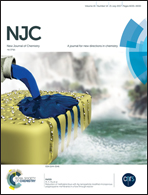Preparation of 2D α-Fe2O3 platelets via a hydrothermal heterogeneous growth approach and study of their magnetic properties
Abstract
We report a novel strategy to modify the morphology of hydrothermal α-Fe2O3 particles via a heterogeneous growth process of BaFe12O19 crystal nuclei based on their structural similarity to α-Fe2O3 as well as their excellent crystallization habit to hexaplates. Various (001)-exposed single phase α-Fe2O3 platelets with diameters of 2.23–11.99 μm and thicknesses of 0.24–2.21 μm were successfully prepared without surfactants by using Fe(NO3)3·9H2O and Ba(NO3)2 as starting materials with NaOH as a precipitant in a facile hydrothermal process. The microstructural characterization by XRD, FESEM and EDS indicates that Ba2+ ions play an essential role in directing the formation of α-Fe2O3 platelets by producing BaFe12O19 nuclei as heterogeneous growth cores. This outcome has been supported by a series of experimental results, such as composition and cell parameter changes, morphology evolution, and the generation of double-layer α-Fe2O3 platelets. To facilitate the nucleation of BaFe12O19 while preventing its further growth, an appropriate NaOH concentration and barium-poor stoichiometry were required. Furthermore, the magnetic hysteresis measurements demonstrated that these 2D α-Fe2O3 platelets exhibit strong shape- and orientation-dependent magnetic properties.



 Please wait while we load your content...
Please wait while we load your content...